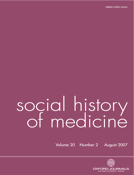-
Views
-
Cite
Cite
Linda Bryder, Britain and the 1918–19 Influenza Pandemic: A Dark Epilogue, Social History of Medicine, Volume 20, Issue 2, August 2007, Pages 411–412, https://doi.org/10.1093/shm/hkm056
Close - Share Icon Share
Extract
The second decade of the twentieth century was not a good time to be a young adult, as Niall Johnson points out in this study of the 1918–19 influenza pandemic. If they survived the ravages of the First World War, and 10 million did not, chances are that they would be struck down by an epidemic which targeted young adults. As Johnson writes ‘in British (as well as French and German) history and literature, the story of the war's “lost generation” is well-known. But another story, not as well-known, is that of the 1918–1919 influenza pandemic. This is a story of as many as one billion ill and 100 million dead’ (p. 37). It is this story which Johnson sets out to tell. He begins by reviewing the medical and biological understandings of influenza, relating the history of the influenza virus up to and including the recent bird flu outbreaks, and analysing the pandemic's geographies and its human costs. He then explores the impact of, and responses to, the 1918 epidemic, examines its cultural dimensions and repercussions, and speculates on the inevitability of future influenza pandemics. His primary focus is Britain, but the pandemic's global dimensions lead him to range further afield, highlighting its universality and drawing international comparisons. His own archival research included Britain, Australia, South Africa and Canada. Coming from a Department of Geography, he comments that his work falls within the remit of both history and geography, but that as it progressed it leant more towards the historical than the geographical. He rightly explains that this is in keeping with the current trajectory of historical-cultural geography which has seen a broadening of what constitutes human geography.




